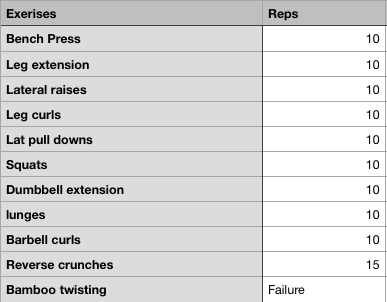Circuit training is a type of interval training in which various strength exercises are combined to give the benefits of both cardiovascular and strength training workouts. (Some strength coaches combine aerobic exercises and strength exercises). The person doing circuit training does one exercise and immediately takes up the second exercise without rest. ‘Circuit’ means a group of stations positioned around the facility that are to be visited in rapid succession.
Circuit training is an excellent way to improve mobility, strength and stamina. Weight training is a means of toning and building muscles & aerobic is a means of increasing the oxygen consumption of the body in order to improve fat loss. In Circuit training we do a set of 6-12 exercises in succession and hence we improve strength and stamina. As we move from one station to another in rapid succession we increase our heart rate and increase the utilization of oxygen and give the benefit of aerobic exercises. This is the reason why most of the trainers suggest circuit training for those aiming at rapid fat loss.
As we utilize weights, we need to allow time for the muscles to recover. So it is highly advisable to train in circuit training fashion on alternate days. Some fitness freaks train alternate days with circuit training and do cardio activities on non training days.
Sample circuit training chart

Sample circuit training chart for women

Generally women tend to carry more loose flesh in their lower body than their upper body, so more emphasis is placed on lower body.
Cooper Clinic study done in 1982 (source webmd.com)
A study was conducted on the effects of doing circuit workout three times a week. The study had 77 participants, who were divided into three groups.
“One group did not train at all,” Westcott says. “One group just did the weights. And the third group jogged in between the weight sessions.”
Not surprisingly, the group that didn’t train saw no improvement in its cardiovascular fitness. The weights group improved cardio fitness by 12%. And the weights-and-jogging group improved 17%. (The weights group also improved strength by 17% and the weights-and-jogging group improved strength by 22%.)